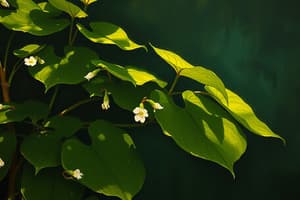Podcast
Questions and Answers
Where does photosynthesis take place in plant cells?
Where does photosynthesis take place in plant cells?
- Cytoplasm
- Chloroplasts (correct)
- Mitochondria
- Nucleus
What is the primary purpose of chloroplasts in plant cells?
What is the primary purpose of chloroplasts in plant cells?
- Energy production (correct)
- Waste elimination
- Protein synthesis
- Cell division
What pigment gives chloroplasts their green color?
What pigment gives chloroplasts their green color?
- Xanthophyll
- Anthocyanin
- Carotene
- Chlorophyll (correct)
Which part of the chloroplast is responsible for the light-dependent reactions of photosynthesis?
Which part of the chloroplast is responsible for the light-dependent reactions of photosynthesis?
What is the end product of the light-dependent reactions of photosynthesis?
What is the end product of the light-dependent reactions of photosynthesis?
What is the main purpose of photosynthesis in plants?
What is the main purpose of photosynthesis in plants?
Where do the light-independent reactions, also known as the Calvin Cycle, occur?
Where do the light-independent reactions, also known as the Calvin Cycle, occur?
What is the main purpose of the Calvin Cycle?
What is the main purpose of the Calvin Cycle?
Where does photosynthesis primarily take place in a plant cell?
Where does photosynthesis primarily take place in a plant cell?
Which molecule is used to convert light energy into chemical energy during photosynthesis?
Which molecule is used to convert light energy into chemical energy during photosynthesis?
What role does respiration play in plants?
What role does respiration play in plants?
Which enzyme is responsible for carbon fixation in photosynthesis?
Which enzyme is responsible for carbon fixation in photosynthesis?
Study Notes
Plants: Chloroplasts, Photosynthesis, and Energy Production
Plants play a crucial role in our ecosystem by producing oxygen through photosynthesis. This process is essential for both plants themselves and the environment they inhabit. Let's dive deeper into the world of plants and explore their role in photosynthesis, chloroplasts, and energy production.
Photosynthesis Overview
Photosynthesis is the process by which plants convert light energy, usually from the sun, into chemical energy in the form of glucose. This glucose is then used as a source of energy for the plant to grow and carry out its day-to-day activities. Photosynthesis occurs in the chloroplasts of plant cells.
The Importance of Chloroplasts
Chloroplasts are organelles found in plant cells. They are primarily responsible for photosynthesis and are named for their green color, which comes from the pigment chlorophyll. Chloroplasts contain thylakoid membranes, where the light-dependent reactions of photosynthesis take place, and stroma, where the light-independent reactions occur.
Light-Dependent Reactions
The light-dependent reactions take place in the thylakoid membranes of the chloroplasts. They involve the conversion of light energy into chemical energy through a series of steps, including the absorption of light, the transfer of energy, and the release of energy. This process results in the formation of high-energy molecules called ATP and NADPH, which are used in the light-independent reactions.
Light-Independent Reactions
The light-independent reactions, also known as the Calvin Cycle, occur in the stroma of the chloroplasts. They are a series of biochemical reactions that use the energy stored in ATP and NADPH from the light-dependent reactions to convert carbon dioxide into glucose. This is done through a process called carbon fixation, which involves the enzyme RuBisCO.
Energy Production in Plants
Energy production in plants is a complex process that involves both photosynthesis and respiration. Photosynthesis is used to convert light energy into chemical energy in the form of glucose, which is then used by the plant for growth and other metabolic processes. Respiration, on the other hand, is the process by which cells convert stored glucose back into energy.
In summary, plants are vital for maintaining the balance of life on Earth by converting light energy from the sun into chemical energy through photosynthesis. This process occurs within chloroplasts, where the light-dependent reactions take place in the thylakoid membranes and the light-independent reactions occur in the stroma. These reactions allow plants to produce ATP, NADPH, and glucose, which are used for energy production and growth.
Studying That Suits You
Use AI to generate personalized quizzes and flashcards to suit your learning preferences.
Description
Explore the essential role of plants in converting light energy into chemical energy through photosynthesis. Learn about chloroplasts, their structure, and functions in the process of energy production in plants through the light-dependent and light-independent reactions.




